Green
Every EV Qualified for U.S. Tax Credits in 2024
![]() See this visualization first on the Voronoi app.
See this visualization first on the Voronoi app.
Every EV Qualified for U.S. Tax Credits in 2024
This was originally posted on our Voronoi app. Download the app for free on iOS or Android and discover incredible data-driven charts from a variety of trusted sources.
This year, the list of qualified electric vehicles (EVs) for U.S. tax credits is relatively small.
Many popular models like the Nissan Leaf, Ford Mustang Mach-E, and some Tesla Model 3s are missing—largely due to new battery sourcing rules. With stricter rules coming into effect, the number of models is dropping from 43 to 13.
This graphic shows the qualifying EV models in 2024, based on data from FuelEconomy.gov.
Which EVs Made the List?
Here are the EVs that are eligible for a U.S. tax credit of up to $7,500 at the point of sale:
| Car | Vehicle Type | Credit Amount | Manufacturer's Suggested Retail Price Limit |
|---|---|---|---|
| Chevrolet Bolt EUV | EV | $7,500 | $55,000 |
| Chevrolet Bolt EV | EV | $7,500 | $55,000 |
| Chrysler Pacifica PHEV | Plug-in Hybrid | $7,500 | $80,000 |
| Ford Escape PHEV | Plug-in Hybrid | $3,750 | $80,000 |
| F-150 Lightning* | EV | $7,500 | $80,000 |
| Jeep Grand Cherokee 4xe | Plug-in Hybrid | $3,750 | $80,000 |
| Jeep Wrangler 4xe | Plug-in Hybrid | $3,750 | $80,000 |
| Lincoln Corsair Grand Touring | Plug-in Hybrid | $3,750 | $80,000 |
| Rivian R1S* | EV | $3,750 | $80,000 |
| Rivian R1T* | EV | $3,750 | $80,000 |
| Tesla Model 3 Performance | EV | $7,500 | $80,000 |
| Tesla Model X Long Range | EV | $7,500 | $80,000 |
| Tesla Model Y* | EV | $7,500 | $80,000 |
*F-150 Lightning includes Standard and Extended Range models. R1S includes Dual and Quad Motor models. R1T includes Dual, Performance Dual, and Quad Motor models. Model Y includes RWD, AWD, and Performance models.
The good news is that getting the discount is now easier for customers.
Instead of filling out tax paperwork to receive the tax credit, buyers will automatically get the discount at participating dealerships at the time of purchasing.
Additionally, models eligible for a partial credit of $3,750 include Rivian EVs along with plug-in hybrids from Jeep, Ford, and Lincoln.
Ultimately, the tax credit is designed to encourage people to switch to EVs and purchase models that are sourced in America. Overall, it is part of a wider plan to boost manufacturing and clean energy investment across the country.
U.S. EV Manufacturing Push
Several automakers are ramping up investment in American battery plants.
In October 2023, Toyota announced it was investing an additional $8 billion in its North Carolina battery plant, adding 3,000 new jobs.
Along with this, Ford is constructing a 3,600 acre facility for battery manufacturing and EV production, valued at $5.6 billion. By 2026, it is targeting to make 500,000 electric trucks annually. Located in Tennessee, the mega-campus is set to create 6,000 new jobs.
Still, Ford is scaling back EV investment, citing a reluctance among customers to pay a premium for electric models. The United Auto Workers deal, estimated to cost Ford $8.8 billion, likely impacted EV investment plans.
The cost of EV batteries can range from around $8,000 to over $22,000.
Automakers including Lucid, General Motors, Honda, Nissan, and Stellantis (Chrysler’s parent company) are all building, or plan to build, battery facilities in the country.
Green
The Carbon Footprint of Major Travel Methods
Going on a cruise ship and flying domestically are the most carbon-intensive travel methods.

The Carbon Footprint of Major Travel Methods
This was originally posted on our Voronoi app. Download the app for free on iOS or Android and discover incredible data-driven charts from a variety of trusted sources.
Did you know that transport accounts for nearly one-quarter of global energy-related carbon dioxide (CO₂) emissions?
This graphic illustrates the carbon footprints of major travel methods measured in grams of carbon dioxide equivalent (CO₂e) emitted per person to travel one kilometer. This includes both CO₂ and other greenhouse gases.
Data is sourced from Our World in Data, the UK Government’s Department for Energy Security and Net Zero, and The International Council on Clean Transportation, as of December 2022.
These figures should be interpreted as approximations, rather than exact numbers. There are many variables at play that determine the actual carbon footprint in any individual case, including vehicle type or model, occupancy, energy mix, and even weather.
Cruise Ships are the Most Carbon-Intensive Travel Method
According to these estimates, taking a cruise ship, flying domestically, and driving alone are some of the most carbon-intensive travel methods.
Cruise ships typically use heavy fuel oil, which is high in carbon content. The average cruise ship weighs between 70,000 to 180,000 metric tons, meaning they require large engines to get moving.
These massive vessels must also generate power for onboard amenities such as lighting, air conditioning, and entertainment systems.
Short-haul flights are also considered carbon-intensive due to the significant amount of fuel consumed during initial takeoff and climbing altitude, relative to a lower amount of cruising.
| Transportation method | CO₂ equivalent emissions per passenger km |
|---|---|
| Cruise Ship | 250 |
| Short-haul flight (i.e. within a U.S. state or European country) | 246 |
| Diesel car | 171 |
| Gas car | 170 |
| Medium-haul flight (i.e. international travel within Europe, or between U.S. states) | 151 |
| Long-haul flight (over 3,700 km, about the distance from LA to NY) | 147 |
| Motorbike | 113 |
| Bus (average) | 96 |
| Plug-in hybrid | 68 |
| Electric car | 47 |
| National rail | 35 |
| Tram | 28 |
| London Underground | 27 |
| Ferry (foot passenger) | 19 |
| Eurostar (International rail) | 4.5 |
Are EVs Greener?
Many experts agree that EVs produce a lower carbon footprint over time versus traditional internal combustion engine (ICE) vehicles.
However, the batteries in electric vehicles charge on the power that comes straight off the electrical grid—which in many places may be powered by fossil fuels. For that reason, the carbon footprint of an EV will depend largely on the blend of electricity sources used for charging.
There are also questions about how energy-intensive it is to build EVs compared to a comparable ICE vehicle.
-

 Science1 week ago
Science1 week agoVisualizing the Average Lifespans of Mammals
-

 Markets2 weeks ago
Markets2 weeks agoThe Top 10 States by Real GDP Growth in 2023
-

 Demographics2 weeks ago
Demographics2 weeks agoThe Smallest Gender Wage Gaps in OECD Countries
-

 United States2 weeks ago
United States2 weeks agoWhere U.S. Inflation Hit the Hardest in March 2024
-

 Green2 weeks ago
Green2 weeks agoTop Countries By Forest Growth Since 2001
-

 United States2 weeks ago
United States2 weeks agoRanked: The Largest U.S. Corporations by Number of Employees
-

 Maps2 weeks ago
Maps2 weeks agoThe Largest Earthquakes in the New York Area (1970-2024)
-

 Green2 weeks ago
Green2 weeks agoRanked: The Countries With the Most Air Pollution in 2023











